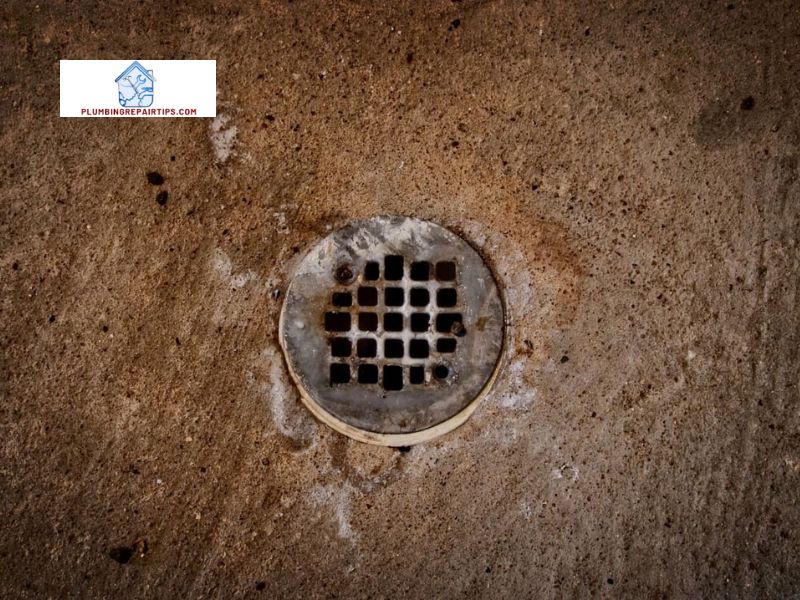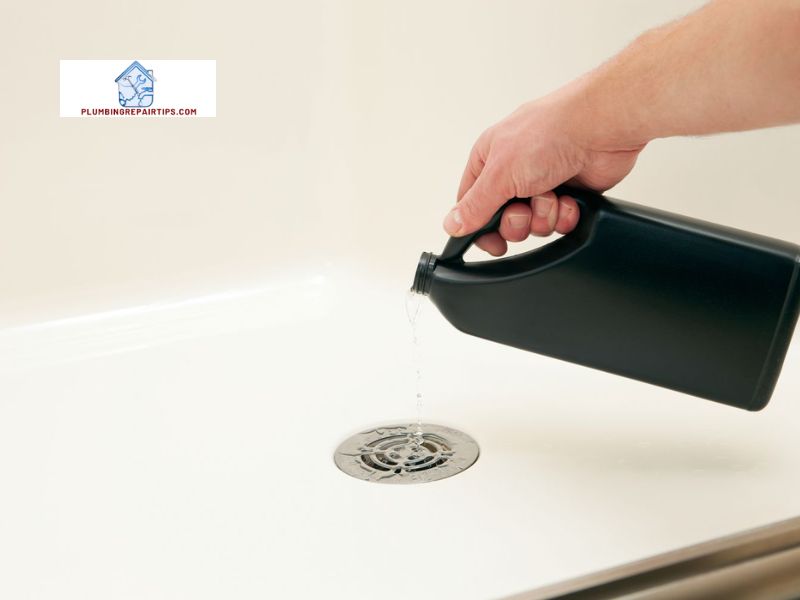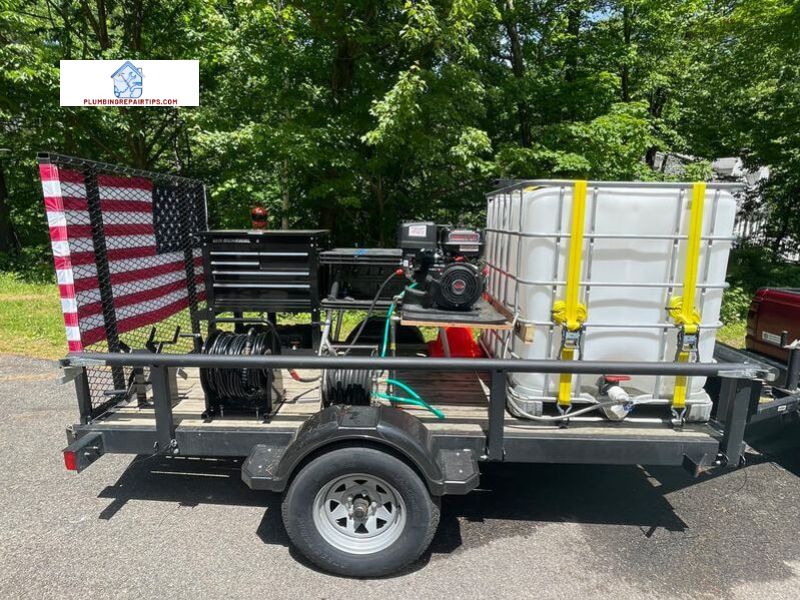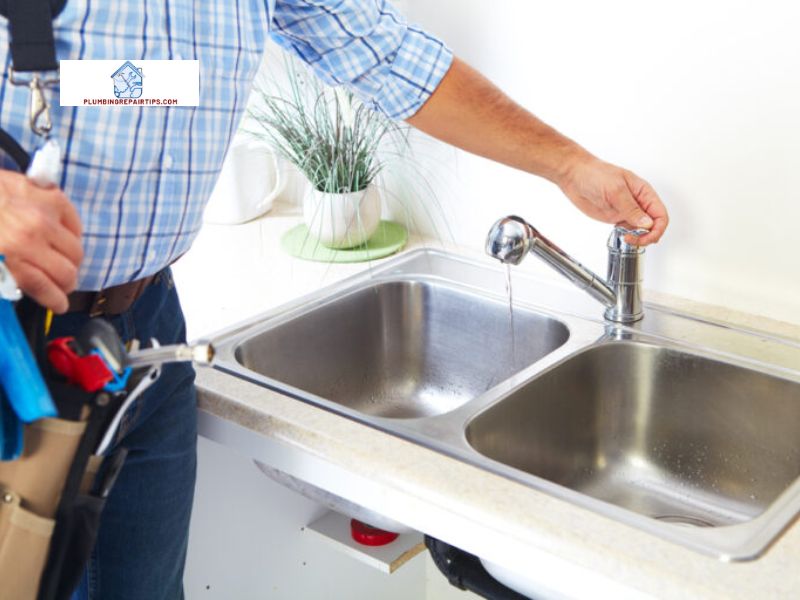Introduction
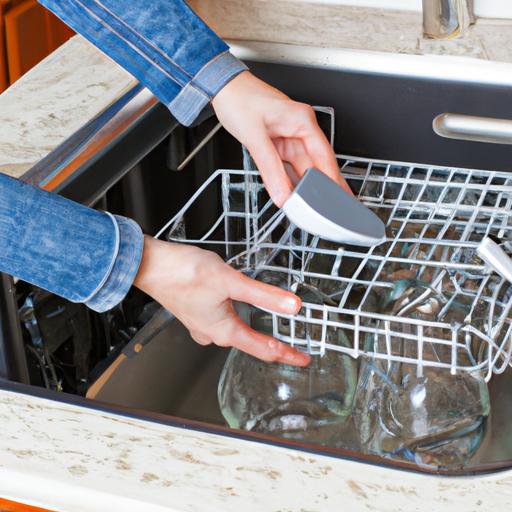
When it comes to our kitchen appliances, we rely heavily on our dishwashers to make our lives easier. However, even the most efficient machines can encounter problems. One such issue that plagues many households is the dreaded dishwasher sink overflow. In this article, plumbingrepairtips.com will explore the importance of proper dishwasher operation, common issues faced by dishwashers, and delve into the specifics of the dishwasher sink overflow problem.
Importance of proper dishwasher operation
Imagine a scenario where you’ve just finished a delicious meal and loaded up your dishwasher with dirty plates and utensils. You press the start button and walk away, confident that everything will be taken care of. But what happens when your dishwasher doesn’t operate as expected? Proper dishwasher operation is crucial for maintaining a clean and functional kitchen. It ensures that your dishes are thoroughly cleaned, sanitized, and ready for reuse.
Common issues faced with dishwashers
Dishwashers are complex appliances with various components that work together seamlessly. However, they can also experience a range of common issues. From dishes not getting clean to strange noises emanating from the machine, these problems can disrupt our daily routines and leave us frustrated. It’s important to address these issues promptly to avoid more significant problems down the line.
Overview of dishwasher sink overflow problem
One particular issue that homeowners encounter is the dishwasher sink overflow. This occurs when water from the dishwasher overflows into the sink, creating a messy situation. The causes of this problem can range from clogged drain pipes to malfunctioning drain valves or improper installations. Recognizing the signs of dishwasher sink overflow, such as water pooling around the sink area or foul odors, is essential for timely intervention.
In the upcoming sections, we will explore preventive measures to avoid dishwasher sink overflow, troubleshoot and fix the issue, and discuss ways to clean up the aftermath. By understanding and addressing this problem head-on, you can restore the functionality of your dishwasher and ensure a smooth and hassle-free kitchen experience.
Stay tuned for the next sections where we’ll dive deeper into each aspect of the dishwasher sink overflow issue and guide you on how to prevent, troubleshoot, and resolve this inconvenience. Let’s tackle this problem together and reclaim the joy of a perfectly functioning dishwasher.
Note: The information provided in this article is intended for general knowledge purposes. If you’re unsure about any specific dishwasher issues, it’s always best to consult a professional plumber or technician for assistance.
Section 1 words
Understanding Dishwasher Sink Overflow
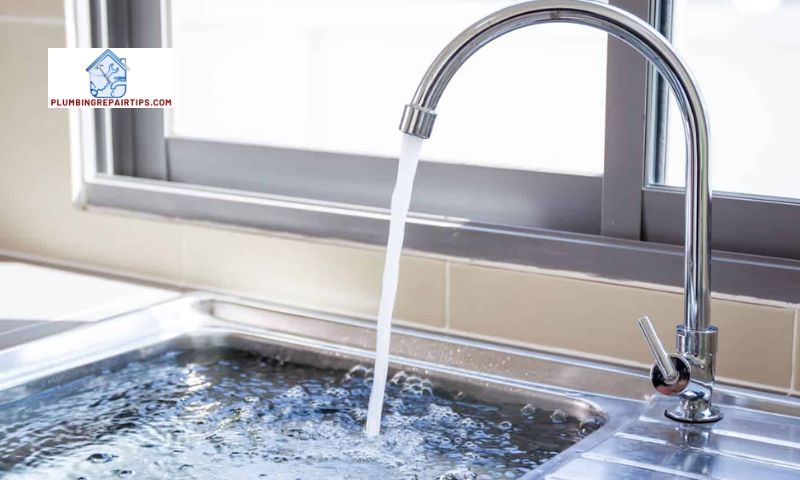
When it comes to dishwasher sink overflow, understanding the causes, recognizing the signs, and being aware of potential damages is crucial. Let’s delve into each aspect to gain a comprehensive understanding of this issue.
Causes of dishwasher sink overflow
- Clogged drain pipe: One of the primary reasons for dishwasher sink overflow is a clogged drain pipe. Over time, debris, food particles, and grease can accumulate, obstructing the flow of water and causing it to back up into the sink.
- Malfunctioning drain valve: The drain valve is responsible for controlling the flow of water out of the dishwasher. If it fails to function properly, water can accumulate and overflow into the sink.
- Improper installation: Incorrect installation of a dishwasher can lead to various issues, including sink overflow. If the drain hose is not connected correctly or the dishwasher is not level, it can disrupt the proper drainage process.
Signs of dishwasher sink overflow
- Water pooling around the sink area: One of the most apparent signs of dishwasher sink overflow is the presence of water pooling around the sink. This may occur while the dishwasher is running or after it has completed a cycle.
- Overflowing water from the dishwasher: If you notice water overflowing from the dishwasher itself, it is a clear indication of a problem. This can be caused by clogged pipes, a malfunctioning drain valve, or other issues.
- Foul odor from the sink or dishwasher: Another sign to watch out for is a foul odor emanating from the sink or dishwasher. When water overflows, it can mix with food debris, leading to unpleasant smells.
Potential damages caused by dishwasher sink overflow
Dishwasher sink overflow can result in more than just a messy kitchen. If left unresolved, it can cause significant damages, such as:
- Water damage to surrounding cabinets and flooring
- Structural damage to the kitchen countertop and sink area
- Mold and mildew growth, leading to health issues
- Electrical malfunctions if water reaches electrical connections
By understanding the causes, recognizing the signs, and being aware of potential damages caused by dishwasher sink overflow, you can take prompt action to prevent further complications. In the next section, we will discuss preventive measures to avoid this inconvenience altogether.
Section 2 words
Preventive Measures
When it comes to avoiding the inconvenience of a dishwasher sink overflow, prevention is key. By implementing a few simple maintenance tips and adopting best practices, you can significantly reduce the risk of encountering this problem. Let’s explore some preventive measures you can take to keep your dishwasher running smoothly.
Regular maintenance tips
- Cleaning the dishwasher filter: The dishwasher filter plays a crucial role in trapping food particles and debris, preventing them from clogging the drain. Regularly cleaning the filter ensures proper water flow and prevents potential blockages. Follow the manufacturer’s instructions to locate and clean the filter, ensuring it is free from any residue or buildup.
- Checking and cleaning the drain pipe: Over time, the drain pipe can accumulate debris and become clogged, leading to potential overflow issues. Periodically inspect the drain pipe for any obstructions and clean it thoroughly to maintain a clear pathway for water drainage. You can use a mixture of vinegar and baking soda to remove stubborn clogs.
- Ensuring proper dishwasher installation: Improper dishwasher installation can contribute to overflow problems. Make sure your dishwasher is correctly installed, with the drain hose securely connected and positioned correctly. Ensure that the drain hose has a loop or high point to prevent backflow. If you’re unsure about the installation process, consult a professional to ensure it is done correctly.
Best practices for avoiding dishwasher sink overflow
- Avoiding overloading the dishwasher: While it may be tempting to fit as many dishes as possible into a single load, overloading the dishwasher can impede proper water circulation and drainage. This increases the chances of an overflow. Follow the manufacturer’s guidelines for loading capacity and distribute the dishes evenly to ensure optimal performance.
- Using the correct dishwasher detergent: Not all dishwasher detergents are created equal. Using the wrong detergent or using too much can lead to excessive suds and overflow issues. Choose a detergent specifically formulated for dishwashers and follow the recommended dosage instructions. Using the correct detergent will help maintain the proper balance of cleaning power without causing excessive foaming.
- Running hot water before starting the dishwasher: Before starting a dishwasher cycle, it’s recommended to run hot water from the sink tap for a few minutes. This helps ensure that the dishwasher receives hot water from the start, which improves cleaning efficiency and prevents potential clogs caused by grease or food particles.
By following these preventive measures and incorporating them into your routine, you can minimize the risk of a dishwasher sink overflow. Taking proactive steps to maintain your dishwasher’s functionality will not only save you from the inconvenience of an overflow but also extend the lifespan of your appliance.
Section 3 words
Cleaning Up and Preventing Future Occurrences
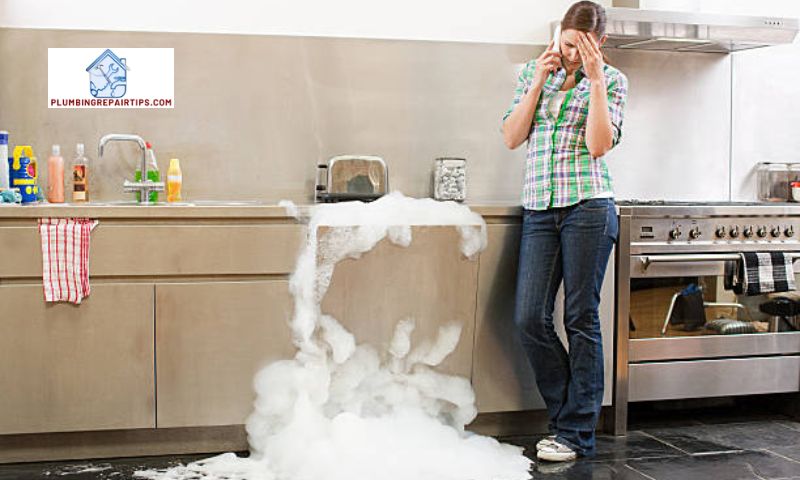
Dishwasher sink overflow can create quite a mess in your kitchen, but fear not! In this section, we will guide you through the steps to clean up after a dishwasher sink overflow and share preventive measures to avoid future incidents.
A. Steps to clean up after a dishwasher sink overflow
- Removing excess water and drying the affected areas: Start by turning off the dishwasher and disconnecting it from the power source. Use towels or a mop to soak up any standing water around the sink and floor. Pay close attention to hidden nooks and crannies where water may have seeped.
- Sanitizing and deodorizing the sink and dishwasher: After drying the affected areas, it’s crucial to sanitize and deodorize to prevent any lingering odors or potential bacterial growth. Prepare a solution of warm water and mild dish soap, and thoroughly clean the sink, dishwasher racks, and any other surfaces that came into contact with the overflowed water. Rinse with clean water and wipe dry.
B. Implementing preventive measures to avoid future overflow incidents
- Regular maintenance schedule: Create a maintenance routine for your dishwasher to keep it in optimal condition. This includes cleaning the dishwasher filter regularly, checking and cleaning the drain pipe, and inspecting for any leaks or loose connections. Refer to your dishwasher’s user manual for specific maintenance guidelines.
- Following best practices for dishwasher usage: Avoid overloading the dishwasher, as it can lead to improper drainage and potential overflow. Scrape off excess food particles before loading dishes, and use the correct dishwasher detergent according to the manufacturer’s instructions.
- Seeking professional inspections periodically: While regular maintenance can go a long way, it’s essential to have a professional plumber or technician inspect your dishwasher periodically. They can identify any underlying issues, ensure proper installation, and provide expert advice on optimizing dishwasher performance.
By following these cleaning and preventive measures, you can minimize the chances of experiencing a dishwasher sink overflow in the future. Maintain a clean and functional kitchen while enjoying the convenience of a well-operating dishwasher.
Remember, prevention is key! Taking proactive steps and being mindful of proper dishwasher usage will save you from the headache of dealing with an overflowed sink and the subsequent cleanup.
Section 5 words
Cleaning Up and Preventing Future Occurrences
Keeping your kitchen clean and free from the aftermath of a dishwasher sink overflow is crucial. In this section, we will discuss the necessary steps to clean up after a dishwasher sink overflow and provide tips on preventing future occurrences.
Steps to clean up after a dishwasher sink overflow
- Removing excess water and drying the affected areas: Start by using towels or a wet/dry vacuum to remove any standing water around the sink area. Wipe down the affected surfaces, including the sink, countertops, and nearby cabinets. Thoroughly dry these areas to prevent mold and mildew growth.
- Sanitizing and deodorizing the sink and dishwasher: After the initial cleanup, it’s important to sanitize the sink and dishwasher. Use a mixture of warm water and mild dish soap to clean the sink thoroughly. Pay attention to any lingering odors by using a mixture of equal parts water and white vinegar to wipe down the sink, dishwasher door, and interior. This will help eliminate any unpleasant smells.
Implementing preventive measures to avoid future overflow incidents
- Regular maintenance schedule: Set up a routine maintenance schedule for your dishwasher. This includes cleaning the filter regularly, checking and cleaning the drain pipe, and inspecting the dishwasher for any signs of wear or damage. By staying proactive, you can prevent potential issues that may lead to a dishwasher sink overflow.
- Following best practices for dishwasher usage: Avoid overloading the dishwasher, as this can hinder proper water drainage and increase the chances of an overflow. Use the correct dishwasher detergent and ensure that it is added in the appropriate amount. Additionally, run hot water in the sink before starting the dishwasher to help maintain proper water temperature throughout the cycle.
- Seeking professional inspections periodically: Consider scheduling periodic professional inspections of your dishwasher. A qualified technician can identify any potential issues and address them before they become major problems. This proactive approach can save you from the inconvenience and cost of a dishwasher sink overflow.
By adhering to these cleaning and preventive measures, you can minimize the risk of future dishwasher sink overflow incidents. Remember, a little attention and maintenance can go a long way in ensuring the smooth operation of your dishwasher and maintaining a clean and functional kitchen.
Note: If you are unsure about any specific cleaning or maintenance procedures for your dishwasher, refer to the manufacturer’s instructions or consult a professional plumber or appliance technician for guidance.
Section words

